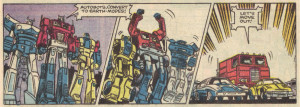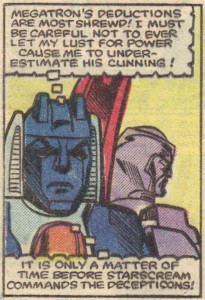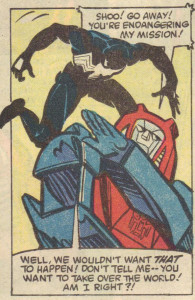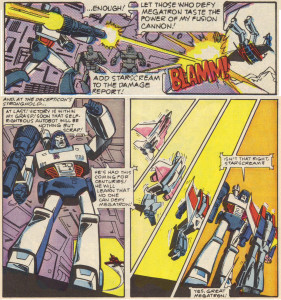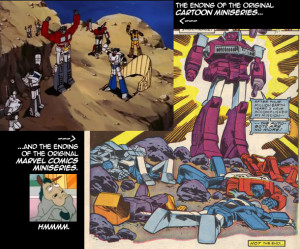This is the second in a series of articles re-visiting Marvel’s version of Transformers, covering the 80 issues released in America and the 4-issue miniseries “The Headmasters.” Images are scanned from my personal copies of each comic.
Over the course of the rest of the original 4-issue miniseries, plot points similar to the cartoon’s “More Than Meets the Eye” are carried out: The Autobots establish a human-Cybertronian relationship with Earth in general and the Witwickies in particular; the Decepticons try to get energy; Starscream plots against Megatron; there are a few big battles; the general status quo is set.
But a couple things differ strongly throughout the arc.
Firstly, the initial conflict in the Marvel comics is not so much that the Autobots needs to stop the Decepticons, but that they lack the energy to do so. In the cartoon, the Autobots’ need for energy is sort of hand-waved at the end of “More Than Meets the Eye.” In the comic it’s presented as a more urgent issue.
Secondly, the human-Cybertronian relationship is far more strained in the Marvel comics. In the cartoon humans almost immediately accept the idea that there are “good” robots and “evil” robots, and Earthen governments seem to implicitly work with the Autobots. In the comics, it’s almost the opposite, with some government units actually appearing to oppose the Transformers (but usually just the Autobots). In the miniseries, we see the seeds of that as Megatron invades various human installations and eventually captures Sparkplug, Buster’s father, eventually resulting in his suffering a heart attack.
A quick summary of these issues: In “Power Play!,” Buster and Sparkplug repair Bumblebee (damaged in issue 1), the Decepticons steal energy from humans, the Autobots debate doing the same (!), the Decepticons capture Sparkplug, and the Autobots collapse due to energy fatique. In “Prisoner of War!,” the Decepticons successfully extract a fuel-conversion method from Sparkplug and, in the comic’s main interaction with Marvel comics continuity, Spider-Man teams up with Gears to rescue Sparkplug. In “The Last Stand,” Sparkplug attempts to flee the vengeful Autobots and is rewarded with a heart attack; the desperate Autobots sacrifice their fuel reserves to power a select few warriors; these few warriors successfully defeat Megatron’s force, who, it turns out, were actually poisoned by Sparkplug’s converted fuel.
But as the smoke clears around the Autobots’ victory, a new threat appears…more on that in a moment.
Some stray thoughts on these issues:
- The attack vehicles the military uses are taken straight from G.I. Joe.
- We see for the first time some examples of Starscream overtly plotting against Megatron, and also of Megatron rewarding Starscream’s duplicity with a fusion blast to the chest. Like in the cartoon, Starscream survives this punishment mostly unscathed.
- Before Sparkplug can explain what he did to the Decepticons’ fuel, he’s actually attacked by the Autobots. This is another example of the poor relationship between Transformers and humans in this comic…unlike the cheerful Sparkplug of the cartoon, Marvel Sparkplug never really considers the Autobots allies after this issue.
- The Gears/Spider-Man teamup is great fun. Writers Jim Salicrup and Bob Budiansky do a good Spider-Man, and I have to admit I love watching him jibe with grumpy Gears. Spidey even gets to fight Megatron, like the cover shows – it doesn’t go so well.
- Unlike the generic, curious Spike Witwicky of the cartoon, Buster is written with some inherent conflict. He’s not satisfied with his destiny as a mechanic, setting him up for a hero’s journey that will be realized through the comic’s initial arcs. Unfortunately his girlfriend, Jessie, is far less interesting than the cartoon’s equivalent, Carly.
- By issue 3, Frank Springer apparently got some actual character models, because the characters start looking more consistent between panels and more like their cartoon appearances. There are still tons of wacky generics in the background, though, and Nel Yomtov‘s coloring is wrong more often than it’s right.
- The Dinobots and Shockwave are introduced in issue 4, and both are totally different than the Sunbow series. The Dinobots have already been on Earth for millions of years, for example, and were actually created by the Ark to fight Shockwave in the Savage Land, another intersection with Marvel Comics continuity that is never again discussed. Shockwave wasn’t left on Cybertron to serve as its guardian, but is instead an independent agent.
Speaking of Shockwave, to wrap this up, let’s talk about that ending.
As the Autobots cheer over their victory, Shockwave appears and, with a single blast, obliterates all of them. This was Budiansky’s way, I think, of shocking readers into continuing to read what was initially planned to be a limited series, but it illustrates the bleakness I talked about previously.
Some of the Autobots that Shockwave destroys in this issue don’t appear in the comic again for forty issues, and the resulting conflict – Ratchet vs. the world – is quite a different status quo than the one in the cartoon.
I feel that this theme, of victory being short-lived and often coming with a very heavy price, is frequently repeated in the comic, by both Budiansky and Furman.
And more on that next time. Meanwhile, ‘til Shockwave makes an illogical choice, Make Mine Marvel!

